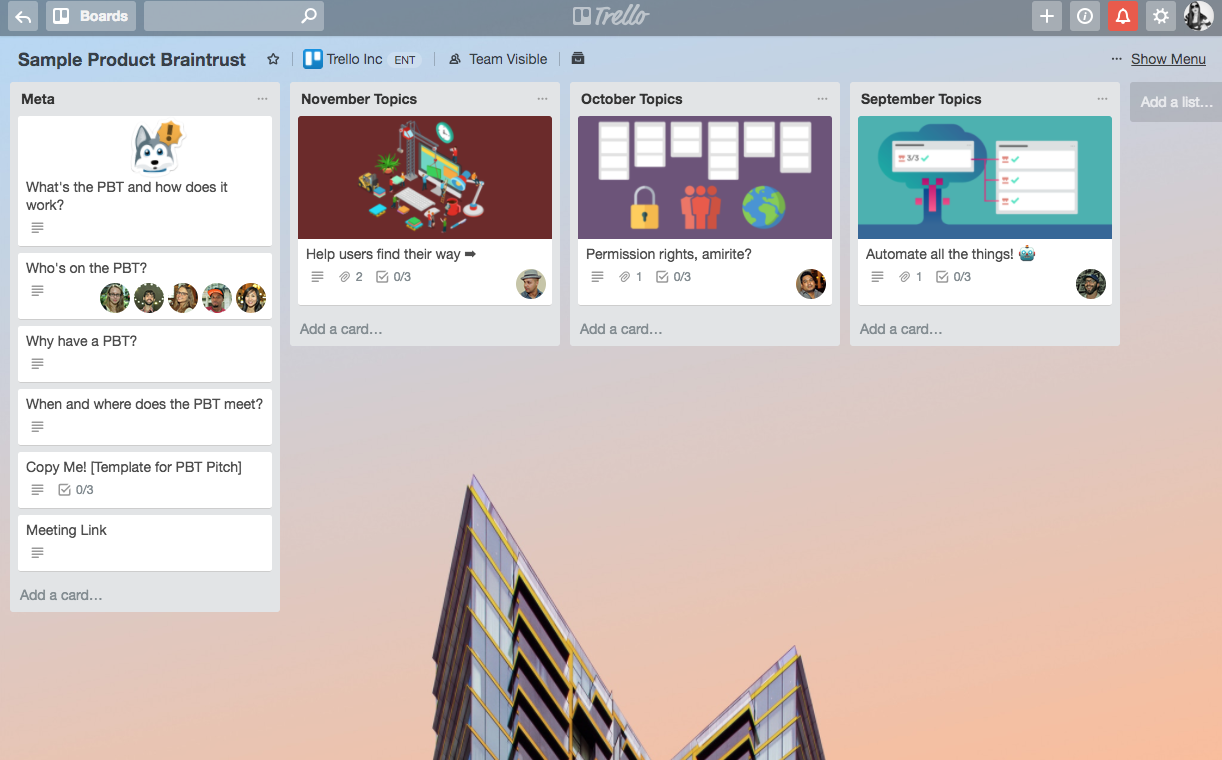When was the last time you got completely unfiltered feedback? Do you dread presenting your big projects to your team because you fear their harsh critique?
With so much at stake, it’s no wonder that so many people choose to play it safe rather than to take a risk. The problem is, playing it safe leads to work that’s average at best.
But it doesn’t have to be this way! Research into feedback abounds, and countless companies are stepping forward to share what works for them. Ed Catmull, co-founder of Pixar and the author of Creativity, Inc., introduced the concept of Braintrusts as a means to encourage more fruitful team feedback.
In his words, “The Braintrust is our primary delivery system for straight talk [at Pixar]. Its premise is simple: Put smart, passionate people in a room together, charge them with identifying and solving problems, and encourage them to be candid with each other.” He attributes the animation powerhouse’s 14 consecutive box office hits back to this think tank team.
Let’s take a look at the core tenets of the Braintrust:
Expert Opinions In A Safe Space
Imagine presenting to your company’s executive team. Does the idea fill you with excitement or dread? Why?
At Pixar, the Braintrust is a monthly meeting of veteran directors to review movies. While each presenter has the utmost respect for these veteran directors and their craft, none of them actually report to any of the braintrust members.
While Pixar’s first Braintrust was the five original members of the Toy Story team, it has grown to include additional directors, heads of story, and writers, all masters in the moviemaking craft.
The mechanics are simple: order lunch, book a conference room with a large table, bring a projector, and dive in. Start laying the ground rules—demand for candor (openness and honesty) and the importance of avoiding solutions. Next, have a Brainstrust member introduce the presenter and provide context for the rest of the team of the project at hand and why it’s important. Then dive into the presentation.
I Respectfully Disagree

While the discussions can get heated, the spirit of the meeting is always to improve the project at hand. It can seem like a small point to shift the feedback from the person to the project, but that is a key secret of successful teams. Instead of hearing “you are bad at writing,” for example, you hear “this specific introduction doesn’t have a strong hook.” Even when that point is made passionately, as the receiver you must internalize that it’s focused on solving the problem, and not at you.
“They argued – sometimes heatedly – but always about the project. They were not motivated by the kinds of things — getting credit for an idea, pleasing their supervisors, winning a point just to say you did — that too often lurk beneath the surface of work-related interactions.”
– Ed Catmull, Pixar
The key is to look at the viewpoints as additive, not competitive. Don’t make the discussion into a debate, measuring each idea against each other. Instead assume that everyone has something to add, even if it’s just part of the conversation. Everyone in the meeting is equal, and everyone is there to help solve problems. With this in mind you will see how valuable this format is. In turn, your team helps you broaden your perspective by helping you to see through their eyes.
Take These Notes If You Want To
At the end of the meeting, the presenter leaves with a volume of notes and questions. They alone have to interpret and develop the best solutions. The Braintrust’s advice is never prescriptive, nor does the presenter need to accept it. The Braintrust’s job is to introduce new perspectives to get the presenter unstuck.
Behind The Scenes: The Braintrust At Trello

Trello recently launched a Product Braintrust. Justin Gallagher, VP of Product and spearheader of the initiative, explained two motivations for starting the PBT:
- Trello has a very specific product philosophy, and it’s crucial to convey and preserve those principles as the company grows. The best way to do that is by talking through the context of real work. For example, one of our newest features, Related Cards, was a recent topic of discussion at Product Braintrust out of a need to solve a real-life issue with tracking cards across boards.
- As Trello grows and more teams find themselves working in parallel, different people are reaching out to different folks for feedback. Sometimes they are receiving conflicting feedback, causing work to stall. Collecting folks in a room to discuss feedback synchronously compresses the time frame.
Trello’s Product Braintrust is focused exclusively on experiences that change the way people use Trello. Because of that, its members represent Product, Engineering, Design, Marketing, Sales, and Support.
Justin shares a few ground rules for Trello’s Product Braintrust:
- The presenter is the primary person doing work on the feature or idea in question. This minimizes ramp up time since the person most familiar with the problem will be speaking to it. Since there will be lots of questions around other solutions considered or research done, a manager or team lead simply won’t be as familiar. Lastly, the ideas from the session are thought starters and it’s important they not be lost in translation.
- Questions and feedback are encouraged, but not solutions. A core tenet of the Braintrust is lack of authority to mandate solutions. This keeps the dynamic more of a peer set instead of a top down relationship. It also provides for more honest conversation if the presenter knows they can dismiss the ideas.
- The onus is on the presenter to figure out how to incorporate the feedback and move forward. The goal of the Braintrust is to get the presenter out of the trees and to see the whole forest. Since the presenter is closest to the problem, they will usually know the best way to move forward. If they get stuck, they’re always welcome to come back and present their revised work at a later date.
If you’re interested in starting your own Product Braintrust, here’s a template from our board:
Check out (and copy) the sample board!
Better, Together
As Ed Catmull explains, “The Braintrust is one of the most important traditions at Pixar. It’s not foolproof–sometimes its interactions only serve to highlight the difficulties of achieving candor—but when we get it right, the results are phenomenal.”
Before you start, remember to lay the ground rules of additive feedback, non-prescriptive ideas, and the importance of candor. Braintrusts are a wonderful vehicle for collecting team feedback and broadening your perspective.
Now get to it. Order lunch, book a room, and see where your greatest ideas can take you!
Next up: Form, Storm, Norm, Perform: The 4 Stages Of Team Productivity





 )
) 





































